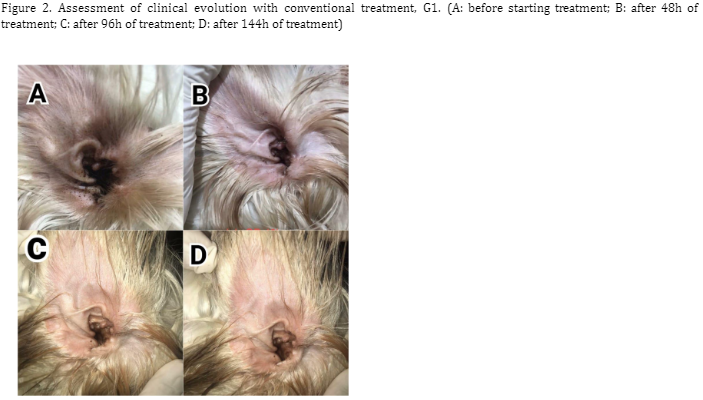Use of antimicrobial photodynamic therapy in the treatment of otitis caused by Malassezia spp. in domestic dogs
DOI :
https://doi.org/10.21708/avb.2023.17.4.11844Résumé
Several factors favor the recurrence of canine otitis due to chronic inflammation, the aim of this research was to evaluate the efficiency of antimicrobial Photodynamic Therapy (aPDT) as an alternative treatment for otitis externa in dogs, compared to conventional topical therapy. Fourteen domestic dogs of different breeds, with spontaneous otitis externa caused by Malassezia spp. were randomly allocated into two groups: conventional topical therapy (G1), with the application of cerumenolytic and an antimicrobial twice a day for seven days (in 14 ears); and aPDT (G2), using a diode laser with 0.1W power, wavelength (ʎ) of 660nm and irradiation every 48 hours, for seven days (in 13 ears). The therapeutic protocol was assessed every 48 h and the times 0 (T0), 48h (T48), 96h (T96) and 144h (T144) were chosen for statistical comparison. Both treatments were efficient in reducing clinical signs, with no significant difference (P>0.05) between them. In the cytological evaluation for Malassezia spp., the mean count at T0 was 25.80 ±5.012 cells/field of 100x in G1 and 40.35±5.216 cells/field of 100x in G2, with no significant difference between the groups before the beginning of treatments (p=1.000). At T144, both groups showed a significant reduction (P<0.05) with a mean count of 2.35 ±0.958 cells/field of 100x in G1 and 3.22±0.997 cells/field of 100x in G2. In conclusion, aPDT provided similar results to conventional therapy, but only required 3 interventions, making it an alternative therapy in cases of otitis with the presence of Malassezia spp.
Téléchargements

Téléchargements
Publié-e
Numéro
Rubrique
Licence
(c) Tous droits réservés Acta Veterinaria Brasilica 2024

Cette œuvre est sous licence Creative Commons Attribution 4.0 International.
Autores que publicam na Acta Veterinaria Brasilica concordam com os seguintes termos: a) Autores mantém os direitos autorais e concedem à revista o direito de primeira publicação, com o trabalho simultaneamente licenciado sob a Licença Creative Commons Attribution que permite o compartilhamento do trabalho com reconhecimento da autoria e publicação inicial nesta revista. b) Autores têm autorização para assumir contratos adicionais separadamente, para distribuição não-exclusiva da versão do trabalho publicada nesta revista (ex.: publicar em repositório institucional ou como capítulo de livro), com reconhecimento de autoria e publicação inicial nesta revista. c) Autores têm permissão e são estimulados a publicar e distribuir seu trabalho online (ex.: em repositórios institucionais ou na sua página pessoal) a qualquer ponto antes ou durante o processo editorial, já que isso pode gerar alterações produtivas, bem como aumentar o impacto e a citação do trabalho publicado (Veja O Efeito do Acesso Livre).


 Esta obra está licenciada com uma Licença
Esta obra está licenciada com uma Licença 